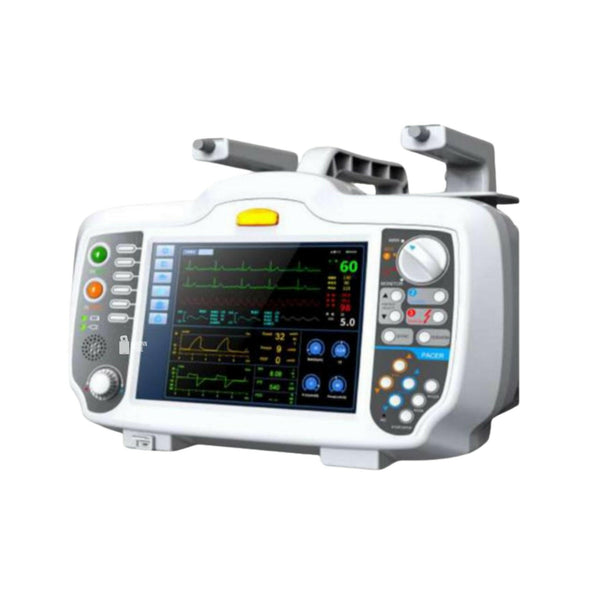

A biphasic defibrillator machine is a type of defibrillator that uses a waveform to deliver an electric shock to a patient's heart in order to restore a normal heart rhythm. The waveform used by a biphasic machine includes two phases of electrical current, which is why it's called "biphasic". The first phase of the waveform sends a small amount of current in one direction through the heart, and the second phase sends a larger amount of current in the opposite direction. This bidirectional waveform is thought to be more effective at restoring a normal heart rhythm than older defibrillator waveforms that used a unidirectional current. Biphasic machines are commonly used in hospitals, emergency medical services (EMS) settings, and other medical settings where patients may experience cardiac arrest or other serious heart conditions.
FEATURES:
BATTERY-LEVEL INDICATOR:
- real-time view of monitor of battery life
INTERNAL THERMAL PRINTER:
- 50MM Integrated Thermal Recorder
PADDLES:
- Charging &shocking can be easily operated through according buttons
- Quickly can be converted from adult to pediatric by removing the outer surface
BIPHASIC TECHNOLOGY:
- With impedance compensation for more effective, less energy and reduced hurt to the heart
DATA STORAGE:
- 65 hours of all measured parameters
Specification
- TYPE WI
- PULSE TYPE Rectangular, constant current
- PULSE AMPLITUDE 0-180 mA+ 10% or 5 mA (whichever is greater)
- PACING RATE Variable from 3pm to 180ppm ±1.5% (increments or decrements by a value of 2ppm
- MULTI-FUNCTION ELECTRODE (MPE) PADS Multi-purpose defibrillation/pacing electrodes
- PAUSE Pacing pulse frequency reduced by a factor of 4 when activated
- REFRACTORY PERIOD NC (WI demand do not have this specification)
- PULSE WIDTH 20+ 1.5ms
- OUTPUT PROTECTION fully defibrillator protected and isolated
SPO2 Module:
- MEASUREMENT RANGE 30-100%, ±2% between 80%-90%, others ±5%
- ALARM RANGE User set high limit and low limit
- ALARM ACCURACY ±10 within setting values
- ALARM TIME ACCURACY Less than 12 sec.
MB_ETCO2:
- TYPE OF SENSOR By-pass RANGE 0-19.7% (0-150mmHg, or 0-20kPa)
- TECHNICAL PRINCIPLE Non-dispersive infrared gas analysis NDIR RESOLUTION0.1 mmHg
- STORAGE CONDITION -40°C to 70°C, <90%RH, non-condensing ACCURACY 0-40mmHg ±2 mmHg 41-70 mmHg ± 5% of reading 71-100 mmHg ± 8% of reading 101-150mmHg ± 10% of reading
- OPERATING CONDITIONS -5°C to 50°C,10 to 90%RH, non-condensing ACCURACY0-40 mmHg ±2 mmHg 41-70 mmHg ± 5% of reading 71-100 mmHg ± 8% of reading101-150 mmHg ± 10% of reading
- AMBIENT PRESSURE 55-115kPa ACCURACY 0-40 mmHg ±2 mmHg 41-70 mmHg ± 5% of reading 71-100 mmHg ± 8% of reading 101-150 mmHg ± 10% of reading
- POWER SUPPLY 5V+5% (max ripple 200 mVp-p) RESPIRATORY RATE* 2-150 BPM
- TDP Typical value 120mA Excursion calibration typical value 280mA RR* MEASUREMENT ACCURACY 1%+ BPM
MB_NIBP:
- MEASUREMENT UNIT mmHg/kPa AMBIENT PRESSURE 55-115kPa
- MEASUREMENT RANGE Adult: 10-270mmHg/kPa Pediatric: 10-200mmHg/kPaNeonatal: 10- 135mmHg/kPa POWER SUPPLY 5V + 5% (max ripple 200 mVp-p) TDPTypical value 120mA Excursion calibration typical value 280mA
- RESOLUTION 1 mmHg RANGE 0-19.7% (0-150mmHg, or 0-20kPa)
- Maximum mean error: 5mmHg Maximum standard deviation: 8mmHg
RESOLUTION 0.1 mmHg
- TYPE OF SENSOR By-pass ACCURACY 0.1mmHg 0-40 mmHg ±2 mmHg 41-70 mmHg ±5% of reading 71-100 mmHg ±8% of reading 101-150mmHg +10% of reading
- TECHNICAL PRINCIPLE Non-dispersive infrared gas analysis NDIR ACCURACY 0.1 mmHg 0-40 mmHg ±2 mmHg 41-70 mmHg ±5% of reading 71-100 mmHg ±8% of reading101-150mmHg +10% of reading
- STORAGE CONDITION -40°C to 70°C, <90%RH, non-condensing RESPIRATORYRATE* 2-150 BPM 1%+ BPM
- OPERATING CONDITIONS 5°C to 50°C, 10 to 90% RH, non-RR* MEASUREMENTcondensing ACLU RACY
Wishlist
Wishlist is empty.
Wishlist
Compare
Shopping cart
Your cart is empty.
Return to shop

